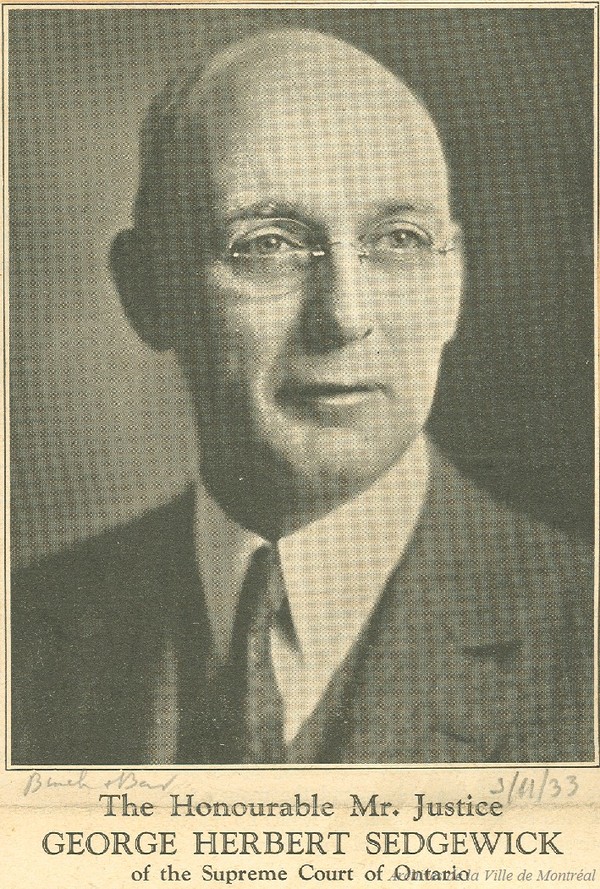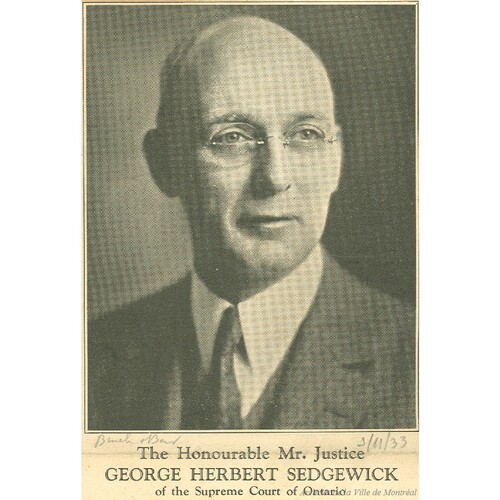
Source: Link
SEDGEWICK, GEORGE HERBERT, lawyer, judge, and civil servant; b. 12 Feb. 1878 in Musquodoboit, N.S., son of William Middleton Sedgewick and Annie Leedham; m. 9 July 1908 Mary Stanley Robertson in Halifax, and they had two daughters; d. 14 March 1939 in Ottawa.
George Herbert Sedgewick was born into a prominent Nova Scotia family. His paternal grandfather, Robert, had come to the province from Scotland in the mid 19th century to minister to the Presbyterian church in Middle Musquodoboit, a charge he held for many years. An uncle on his father’s side, Thomas, was a leading Presbyterian clergyman, and another, Robert*, was a lawyer who became the federal deputy minister of justice under John Sparrow David Thompson* and a judge on the Supreme Court of Canada. After attending Halifax and Pictou academies, George continued his education at Dalhousie University (ba, 1902) and Osgoode Hall law school in Toronto.
At that time, in addition to attending lectures at Osgoode, a student read law with a practitioner. Sedgewick’s mentor was William Renwick Riddell*, a litigator in the prominent firm headed by William Henry Beatty* and Thomas Gibbs Blackstock. It is possible that he secured this position because of his uncle’s connections with Thompson and the relationship between the minister of justice and Beatty Blackstock. Thompson had used Blackstock for legal advice, and one of his sons had been a student in the practice.
Following his call to the bar in 1906, Sedgewick joined Beatty Blackstock. He prospered as a litigation counsel, and when the firm split in 1913, he stayed with the group led by David Fasken*. In May two years later he was given a share of the profits and a guarantee that his income would be no less than $3,000 in his first year, $3,300 in the second, and $3,600 in the third. In 1917, after Hugh Edward Rose had been appointed to the bench, Sedgewick became a nominal partner in the firm, now called Fasken, Robertson, Chadwick, and Sedgewick. Although never a full partner, he remained there until 1925, when he had a falling-out with the domineering managing partner, David’s brother Alexander. Sedgewick, according to the memoirs of another member, was “a gentleman at all times … [but] found the strain and pressure at the office very hard.” After leaving the Fasken firm, he joined what became Malone, Malone, Sedgewick, and Montgomery, where he seems to have had a mixed practice; he was described in some sources as a barrister and in others as a corporation lawyer. His departure from Fasken Robertson did not in any way detract from his reputation in the community, and in 1928 he became a kc.
On 16 December two years later Sedgewick was elevated to the High Court division of the Supreme Court of Ontario. He again filled a vacancy created by Rose, who had been made chief justice of the High Court. His tenure as a judge was short and not especially distinguished. The crowning point occurred in 1932 when he and his former mentor, Riddell, now a member of the Ontario Court of Appeal, were chosen to conclude a provincial royal commission, conducted first under William Edward Middleton* and then under John Fosbery Orde, to “inquire into certain matters concerning the Hydro-Electric Power Commission of Ontario.” Of particular interest were payments made to John Aird Jr in connection with the purchase of electricity from the Beauharnois Light, Heat and Power Company and other sources. Riddell and Sedgewick acted quickly; they were appointed on 19 August and, having reviewed the evidence already presented, they delivered their report, clearing the power commission and Aird, on 31 October.
In the summer of that year Prime Minister Robert Bedford Bennett* had presided over the Imperial Economic Conference in Ottawa. After his election in 1930 he had sought to deal with the Great Depression in part by significantly raising tariffs on imports. British textile interests, among others, complained. During the conference Bennett agreed to seek out someone to head the Tariff Board, which had been established in 1931, and look into the appropriateness of Canadian duties in the light of local and foreign costs of materials, labour, and distribution. He approached Sedgewick, who was made chairman of the board on 6 Feb. 1933, the other appointees being Saskatchewan mp Milton Neil Campbell and wholesale grocer Charles Hébert of Montreal. Sedgewick had been reluctant to accept the position and had evidently negotiated better terms with the prime minister: in early May Bennett introduced an amendment to the Tariff Board Act increasing the pension of board members and raising the annual salary of the chairman from $12,000 to $15,000, so that Sedgewick’s “financial position should not be worse than it would have been had he remained on the bench.”
Given the tensions that Bennett’s tariffs had engendered, Sedgewick was a good choice. He was described by one commentator in January 1933 as possessing “qualities of cool judgment and kindly courtesy” and “a gentleness which conduces to peace in any assembly of which he is a member.” He immediately undertook an investigation of duties on British textiles, travelling across Canada and to England. His report was warmly received in both countries and contributed to his being made a cmg in 1935.
A “strong Presbyterian,” Sedgewick was an elder in St Andrew’s Church in Toronto. Unlike his brother the Reverend William Henry, who had been active in the movement that led many Presbyterians to join with the Methodists and Congregationalists to form the United Church of Canada in 1925 [see Clarence Dunlop Mackinnon], he remained with his congregation after it voted to stay out of the union. Four years later he was a member of a committee set up to plan the centennial celebrations of St Andrew’s in 1930. Politically and socially conservative, Sedgewick had a keen sense of public responsibility, serving as chairman of the board of the Canadian National Institute for the Blind, an adviser to the Salvation Army, president of the board of Central Neighbourhood House in Toronto, and head of the international literature service of the League of Nations Society in Canada. He was twice chosen president of the University Club of Toronto and led the city’s Canadian Club in 1926. His recreations were golf and fishing.
In March 1939, while still chairman of the Tariff Board, Sedgewick had a heart attack during a meeting with government officials. He died shortly after at his home in Ottawa at the age of 61 and was buried in Halifax in his native Nova Scotia.
Law Soc. of Upper Can. Arch. (Toronto), PF 189 (Fasken Martineau DuMoulin LLP fonds), 1-3 (letter agreement signed by Sedgewick), 2-1 (J. B. Robinson memoirs). Daily Mail and Empire, 17 Dec. 1930. Globe, 7 Feb., 10 May 1933. Globe and Mail, 15 March 1939. Can., House of Commons, Debates, 9 May 1933: 4749–52. Canada Gazette, 11 Feb. 1933: 1899. Canadian who’s who, 1936/37. Jean Graham, “O upright judge! Mr. Justice Sedgewick,” Saturday Night, 7 Jan. 1933: 8. C. I. Kyer, “The transformation of an establishment firm: from Beatty Blackstock to Faskens, 1902–1915,” in Essays in the history of Canadian law, ed. D. H. Flaherty et al. (10v. to date, [Toronto], 1981– ), 7 (Inside the law: Canadian law firms in historical perspective, ed. Carol Wilton, 1996): 161–206. S. C. Parker, The book of St. Andrew’s: a short history of St. Andrew’s Presbyterian Church, Toronto (Toronto, 1930). Jennie Reid, Musquodoboit pioneers: a record of seventy families, their homesteads and genealogies, 1780–1980 (2v., [N.S.], 1980), 2: 654–58 (also available online at www.rootsweb.ancestry.com/~canns/musq2.html). Who’s who in Canada, 1934/35.
Cite This Article
C. Ian Kyer, “SEDGEWICK, GEORGE HERBERT,” in Dictionary of Canadian Biography, vol. 16, University of Toronto/Université Laval, 2003–, accessed April 29, 2025, https://www.biographi.ca/en/bio/sedgewick_george_herbert_16E.html.
The citation above shows the format for footnotes and endnotes according to the Chicago manual of style (16th edition). Information to be used in other citation formats:
| Permalink: | https://www.biographi.ca/en/bio/sedgewick_george_herbert_16E.html |
| Author of Article: | C. Ian Kyer |
| Title of Article: | SEDGEWICK, GEORGE HERBERT |
| Publication Name: | Dictionary of Canadian Biography, vol. 16 |
| Publisher: | University of Toronto/Université Laval |
| Year of revision: | 2016 |
| Access Date: | April 29, 2025 |



